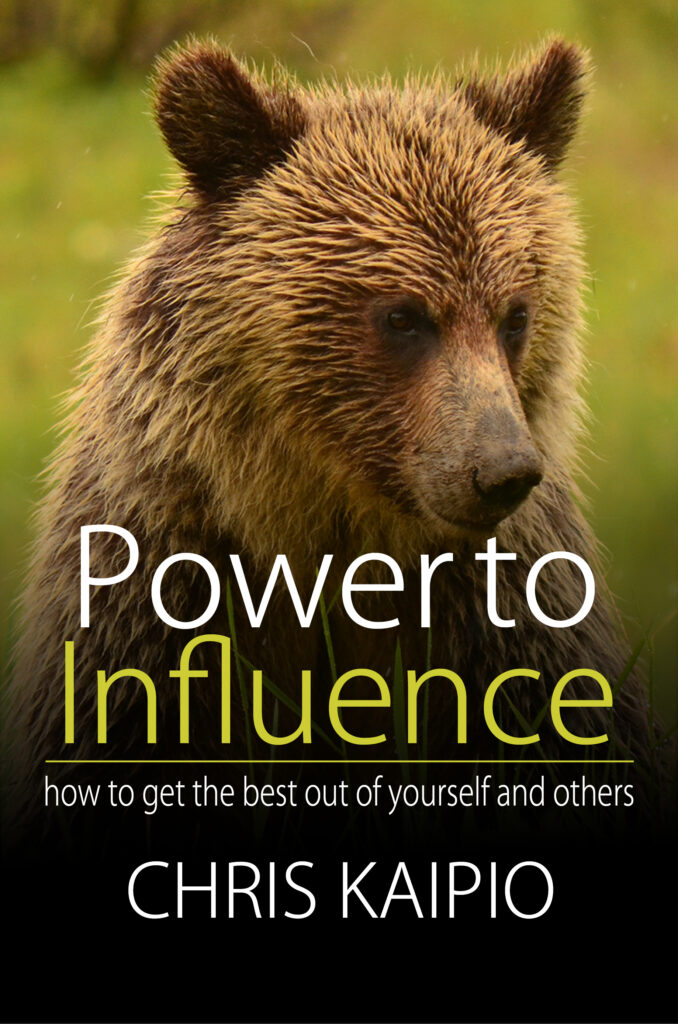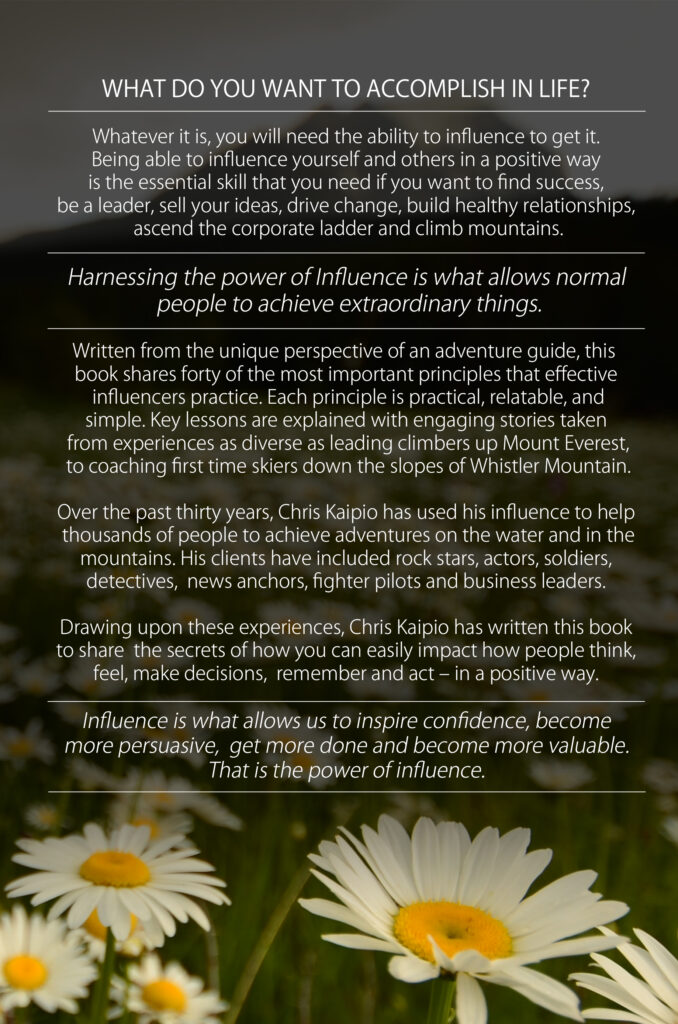

Harness the Power of Your Influence
Influence is the essential skill that allows us to do everything. It enables us to become leaders, change thinking, sell ideas, drive innovation, affect behavior, increase wealth, improve performance, build relationships, and achieve success. Influence is what allows normal people to achieve extraordinary things. Luckily, becoming good at influencing is easier than you might think.
Written from the unique perspective of an adventure guide, The Power of Influence shares the forty-one fundamental principles of influencing that you need to know. Each principle is explained with a blend of storytelling, philosophy, and wisdom. Key insights are highlighted with engaging stories taken from experiences as diverse as leading climbers up Mount Everest to coaching skiers down the slopes of Whistler Mountain.
This book shares with you the secrets of how you can easily impact how people think, feel, make decisions, remember and act – in a positive way. When you can do this, you will have harnessed the full power of your influence.
Available exclusively on Amazon or at Armchair Books in Whistler
Introduction
The ability to influence isn’t an optional life skill, it is mandatory.
The Essential Skill
Influence is what allows normal people to accomplish extraordinary things. It allows us to sell our ideas, promote our innovations, change minds, inspire people, improve performance, deliver experiences, and motivate ourselves. It also allows us to create new things, achieve goals, push our limits, convince people to do things that they may not want to do, and to overcome challenges. This makes influence the essential skill that everyone needs to master.
For the past thirty years, I have used my influencing skills to lead thousands of people on adventures in the mountains and on the water. Being an adventure guide is an incredibly rewarding experience. Working as a guide, you get the opportunity to help people succeed in situations that they often believed were beyond their capabilities. Adding to this, adventure guides frequently get to share achievements with their clients, in interesting and often exciting environments.
Unfortunately, when it comes to guiding adventure, things don’t always go the way you want. The very nature of guiding people on outdoor experiences involves a degree of risk. Balancing this risk effectively requires a guide to make hundreds of calculations each day. Each calculation has to weigh the opportunity of experiencing the reward that comes with pushing a person’s limits, against the possibility of something going wrong. Wrapped up in each calculation are dozens of factors that work to influence a guide’s judgment. Some of these factors are obvious, while others are unseen and possibly unrealized.
It is not surprising then, that mistakes are made by even the most experienced guides. However, what often defines a master guide, is their ability to turn what could have been a catastrophic misadventure, into an experience that is remembered for all the right reasons. This is where influence comes in.
Bruce Wilson shared a story with me that highlights this very situation. Bruce is a sea kayak guide trainer, avalanche educator, University Instructor, and leadership trainer and I consider him to be a master guide. Early in Bruce’s career, he was running a seven-day sea kayaking trip off the west coast of Vancouver Island, in British Columbia.
On day three of the trip, the plan was to paddle along the west side of Flores Island, north of Tofino. This part of the coast is exposed to the open ocean with the next piece of land to the west, being Japan. When Bruce woke up that morning, he was concerned that the sea state would be too much for his group of eight kayakers to handle safely. However, he felt pressured to deliver what was advertised to his clients. He also felt direct pressure from them as they wanted to go for it. They were excited and like many clients on guided trips, they didn’t fully appreciate how difficult the conditions could be. That is why they needed a guide.
Reluctantly, Bruce set out with his group. Initially, the water was calm as the area that they were paddling was protected by an offshore reef. However, after half a kilometre the reef ended and Bruce could see that the ocean beyond was a caldron of breaking waves. Seeing these conditions, Bruce immediately shouted to his group to turn around.
Unfortunately, six of the clients ignored his instructions and continued onwards into the heavy surf. These six clients were paddling two double kayaks and two single kayaks. To Bruce’s dismay, only two of his clients heeded his warning and turned around. Within moments, one of the two single kayaks that had gone past Bruce, was forced backwards by the surf into one of the double kayaks. In the process, the rudder of the single kayak ended up slicing right through the top of the double, lacerating the leg of one of the clients in the process. Then the single kayak capsized. Right after that, the other single kayak capsized.
Within a short time, what should have been an amazing adventure, turned into chaos. Two clients were in the water and the boats were being battered by the surf. Making things even worse, was the fact that the two clients paddling the second double kayak, had blasted out to sea on their own and had disappeared from Bruce’s view.
Like any guide in this situation, Bruce’s stress level spiked to levels that no one wants to experience. Years later, he still remembers his internal voice yelling at him, “I can’t believe this is happening!”
However, like a true professional, he kept his composure. Bruce pushed aside his initial shock and quickly sprung into action as his training and experience took over. Just as quickly as things had fallen apart, Bruce had rescued both of the swimmers and had turned what was left of his group, back towards the beach. By this time, fog had moved in and he still couldn’t see where the second double kayak had gone.
Bruce knew that he couldn’t worry about them at that moment though. He had to look after the rest of his group before he could go searching. When they arrived back at the beach, he got a fire going and attended to the client who had the lacerated leg.
Once he felt that things were under control, he paddled out to look for the two missing guests. Bruce had no idea where his last two clients were, or what had happened to them. He was relieved when he found them bobbing safely offshore out beyond the breaking surf. When the rest of the group didn’t appear, they had decided to wait.
In the end, no one was seriously hurt and to Bruce’s surprise, five of the eight guests came back for a trip with him the next year. However, they did comment that the trip the year before had been more exciting!
When we look at this situation from the perspective of influencing, we can see that there are many layers to this story. To start with, the reason that Bruce’s group got into trouble, was because of the bias factors that influenced Bruce’s decision making. In this case, Bruce felt pressure to deliver an amazing experience to his guests. This is a pressure that most guides succumb to at some point in their careers, often multiple times.
This pressure caused Bruce to make a decision that he may not have made otherwise. However, it was his ability to use the power of his influence effectively that turned what could have been a catastrophe, into an adventure. When it mattered most, Bruce was able to keep calm, stay focused, communicate the right directions to his clients and make the right decisions that inevitably kept them safe. Other people in his place may have panicked when they saw everything falling apart around them. However, Bruce isn’t like most people. He kept his composure, concentrated on finding solutions, took the initiative to manage his group and did what needed to be done. This is the hallmark of a great leader.
Going farther, he was able to frame the experience as a learning opportunity for himself and his guests. That is what allowed them to see the experience through a positive lens. This is why five of them returned to kayak with Bruce again the next year.
When viewed through a critical lens, this situation could have easily been defined by a mistake. However, from the perspective of the people involved, it became a crucial part of an extraordinary achievement. That achievement that only happened because of his ability to harness the full power of his influence in a positive way.
Harnessing our Influence
Influence is what allows us to get the best out of ourselves and other people. After thirty years of leading people down ski runs, up mountains, across lakes, down rivers and in board rooms, I have learned a great deal about influencing people.
Over the years, my clients have included: rock stars, actors, soldiers, secret service agents, politicians, magicians, spiritual leaders, businesspeople of all kinds, teachers, doctors, bankers, news anchors, writers, Olympians, fighter pilots, submariners, race car drivers, undercover drug agents, police officers, criminals, scientists, and prison guards. Each of these people have had something valuable to share with me. Often these lessons have come through their words of wisdom and sometimes through the mistakes that I have made guiding and instructing them.
What I have learned is that people can be difficult, and they will constantly surprise you. People can be irrational and unpredictable. They can misrepresent themselves and they can withhold the truth. People can misinterpret intentions and advice, just as they can misremember events and instructions. Some people can be hard to read, and it can be a challenge to know what they want. There are times when people may not even know what they want themselves. People under stress behave much differently than they do when they are relaxed. Topping all of this off, is the fact that each person is unique. When it comes to dealing with people, there is no normal.
However, I have learned that if you can find ways to make people feel good about themselves and what they have done, you can build connections with even the most difficult person. Unfortunately, while each of us can access the power that influence offers us, most people don’t fully capitalize on its potential. I believe that this happens because most of the time, we just are not that aware.
In my line of work, I get to see a lot of bears. One thing I have come to appreciate is that a grizzly bear is an amazing animal. Its long claws are perfectly designed to excavate the earth leaving ground squirrels and marmots alike with few safe places to hide. They can climb up incredibly steep slopes and they are amazing swimmers. A male grizzly bear can swim up to seven kilometres across open water and it can run faster than the fastest human being over the roughest terrain.
However, while grizzly bears have a deservedly fearsome reputation, most bears go out of their way to avoid contact with humans. Of course, there are bear attacks, but bears are similar to people in that they generally prefer to avoid conflict.
In the summer, my partner Jeannie and I guide weeklong hiking tours in Banff National Park. One evening, we were with our group when we came upon an adult grizzly bear feeding on berries beside the Lake Louise campground. We watched from the safety of our van as this bear stripped the berries from one bush after another, like a giant vacuum cleaner. I have heard that an adult grizzly bear can consume up to two hundred thousand berries in a single day and watching this bear, I could see how.
All eyes were focused on the bear and our clients knew that they were witnessing a once in a lifetime animal sighting. Then out of nowhere, a mountain biker appeared right beside the bear. We all gasped as we watched this biker pass within mere meters of the bear. I can only guess that the bear had been screened from the view of the trail by trees. It wasn’t until the biker had ridden past the bear that she came to realize just how close she had gotten. The bear itself probably weighed two hundred and fifty kilos, so a conflict wouldn’t have been good for the woman on the bike.
What I found fascinating though, is that the bear did not even lift its giant head. It was completely absorbed in what it was doing and had been completely oblivious to the presence of the mountain biker.
Reflecting on the bear and the biker, the lesson for me is that we generally only find the things that we go looking for. In this instance, the bear found plenty of berries. However, the mountain biker probably wished that she had seen the grizzly bear before she had ridden her bike right beside it. Instead, she had been blind to the danger that the bear could have posed. If the bear had been in a different mood, or if it had felt threatened by her surprise arrival within its personal space, things may have turned out very differently.
When it comes to realizing the full power that influencing gives us, we can be just as unaware as the bear and the mountain biker had been to each other’s presence. The path to becoming an effective influencer is not always obvious. In fact, quite often what we need to do to be successful, goes against our instincts.
Becoming an effective influencer requires a conscious, focused effort. People rarely become good at anything by accident. Becoming a good influencer is no different. What you will find is that effective influencers are always aware of how their thoughts, words and actions affect themselves and the people around them. This contrasts with the people who struggle to find success and happiness. Instead of being aware, these people are often as blind to the power of their influence as the mountain biker was to the presence of the bear.
The good news is, it is easier to become an effective influencer than you might think. What I have discovered is that there are forty simple principles that can greatly increase your ability to influence. I wouldn’t classify these principles as secrets because they are hiding in plain sight. However, there is a good chance that you have not really given much thought to many of them – and neither have most other people.
I wrote this book to share with you how you can become better at harnessing the power to influence yourself and others in a positive way. This is the key to becoming more convincing, motivated, likeable, and ultimately more successful at achieving whatever it is that you want to achieve.
The power to influence gives us the opportunity to change how people think, feel, act and remember in a positive way. When we use our influence in this way, we can become more effective, more productive, and more valued.
Influence is the essential life skill that you need to master. This book shows you how to use this skill more effectively, one principle at a time.
Objectives:
- Learn forty of the key principles of influence that will allow you to make yourself more valuable, advance your career, pursue your goals, and build better relationships.
- Improve your ability to motivate yourself in a way that allows you to achieve extraordinary things so that you can become the best version of yourself.
- Identify practical strategies that will help you to influence other people so that you can get the best out of them.
Recommendations
- Try reading a chapter a day. This will give you time to reflect on the lessons and strategies that relate to each principle.
- Engage your friends, family, and colleagues to see what their experiences and insights might be as they relate to each principle.


